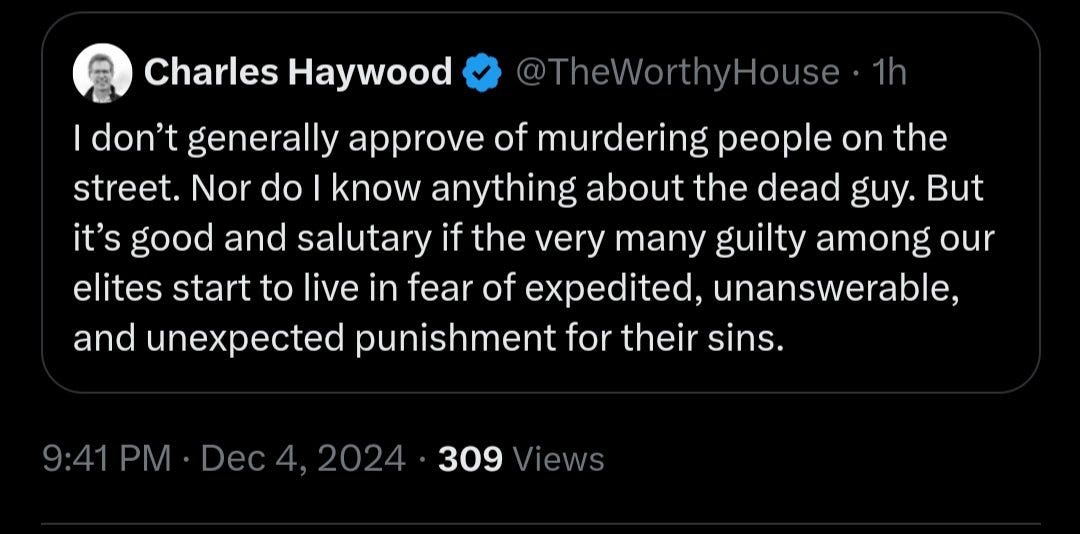An Execution in Manhattan
On the woke left, the woke right, and the murder of Brian Thompson
This post is free to share. To enjoy exclusive subscriber content and privileges, consider taking advantage of my year-end sale and taking out an annual subscription for just $30. Thanks for reading.
A man was shot down in cold blood on the streets of New York this week. By itself, this is nothing unusual. But the case has made headlines because the victim, United Healthcare CEO Brian Thompson, happened to be a rich man in a loathed profession. The mob has hereby deemed him unworthy of life.
Among the left, dancing on rich men’s untimely graves is a time-honored tradition. Last year, I observed the vile reactions to the deaths of the billionaires on board the Titan submarine. One of them had brought his son, but even he was tainted, in their ruthless eyes. The liturgy of gloating was familiarly despicable.
So, it’s no surprise to see the liturgy being repeated now, from the proudly self-ID’ed “commie” Columbia professor, to the ex-WaPo columnist, to the numerous anon accounts spewing obscenities at me and other writers because we dared to say that cold-blooded murder is, in fact, bad. Someone compares Thompson to Nazi death camp planner Rudolf Höss. Someone else compares him to Osama bin Laden. Here we see a leftist breathlessly praising what seems to have been an Easter egg reference to a book on insurance corruption (titled Delay Deny Defend) in the words the killer scratched on his bullet casings: “deny,” “defend,” “depose.” Sic semper tyrannis…or something.
However, it’s not just the woke left breaking out party hats and confetti this time. It’s the woke right too.
What exactly is the “woke right”? This question has been a subject of much debate over the last few years. You can find an in-depth defense of the phrase by Neil Shenvi here. Essentially, Shenvi and others have argued that you can observe a horseshoe effect in comparing the rhetoric of the fringe left and the fringe right. Similar patterns of analysis emerge, as both sides speak in terms of systemic oppression and the need to wage class, gender, or race-based identity war against dominant power structures. And the language of war is not merely metaphorical. Alt-right ex-industrialist Charles Haywood openly looks forward to the collapse of the government and the rise of armed patronage networks, with himself as their “warlord.” He matter-of-factly explains that “Achieving Foundationalism [the name he’s given to his vision/philosophy] will inevitably occur, in part, by first passing through chaos and violence.” After the attempt on Trump’s life, Haywood was among the loudest voices calling for reckless leftist social media posters to lose their livelihoods, on the grounds that they were “footsoldiers for evil.” (Read my analysis of that discourse here.)
In the wake of Thompson’s death, Haywood chose to weigh in with a tweet cleverly worded so as not to constitute approval, strictly. But its intentions were clear:
As commentators like Bari Weiss began quote-tweeting, Haywood deleted, but doubled down with a followup rolling his eyes at the backlash to his “perfectly good and excellently insightful post.” In his replies, writer C. Jay Engel agreed that “people are too emotional on the Internet.”
Engel wrote a vigorous rebuttal to Neil Shenvi’s analysis of the woke right in the American Reformer, arguing that Shenvi fails to recognize how “moderate” liberalism is really tyranny in disguise. There’s a grain of truth to Engel’s analysis, in that we have seen many times over how autonomous choice devours itself when the kindly liberal mask starts slipping. But this is an old critique, one that conservative analysts were making for years before the alt-right arrived on the scene. If Engel and other analysts were simply recapitulating that critique, there would be nothing objectionable in their work. The real problem Shenvi has highlighted is that they demand a wholesale rejection of the idea that we should judge people as individuals.
It is that wholesale rejection that we see consistently on display in the rhetoric of Charles Haywood, someone writers like Engel openly admire (here, for instance, he gives a sustained defense of Haywood’s “no enemies to the right” philosophy). I could give other examples. Consider this from popular pundit Peachy Keenan: “Unrelated but United Healthcare is the worst health-related company on the planet, an absolute nightmare, they make Blue Shield, which is run by literally Satan himself, seem benevolent and generous by comparison.” “Unrelated” is sarcasm, of course. Keenan knows exactly what she’s doing. As a picture has circulated of a person of interest (popularly assumed to be the killer), she shared it asking “Can I say something without everyone getting mad?” which is Internet code for saying she finds him attractive.
In other words, Keenan is making precisely the same rhetorical move as the left—seeing Thompson not as an individual, but as the avatar of an oppressive system of “elites.” And this, as Peter Savodnik rightly notes, is precisely how you get gulags and killing fields. It is how you got Robespierre’s guillotine—a reference someone has already unironically applied to Thompson and “the rest of them.”
This, I think, was the motivating concern behind liberal provocateur James Lindsay’s recently unveiled hoax essay at American Reformer, in which he took sections of The Communist Manifesto and rewrote them into something resembling a New Right manifesto, then submitted it under a pseud. It was a twist on the Sokal Squared hoax he and his colleagues pulled off at various post-modern journals a few years ago, preparing nonsense articles and racking up actual acceptances. One of those articles was a spoof on Mein Kampf. His Marx spoof went similarly undetected and ran with minimal edits.
Much back-and-forth has ensued between fans and detractors of American Reformer over what this reveals about their project. Lindsay offers a detailed breakdown here, for those interested. Myself, I found the spoof to be a mashup of clever parallel and clumsy replacement. Its chief flaw is that, as a committed liberal atheist, Lindsay believes there is no salient criticism to be made of the liberal project, including the sorts of criticisms made by Christian social conservatives. This means he considers it a successful troll to have swapped in (among other things) straightforward socon language about tyrannical liberal assaults on the family. But this is simply replacing false things with true things. To that extent, the editors have a point. And I should state here for the record that I reject all lazy attempts to smear them as Nazis, racists, etc., even if I disagree with their project. By chance, I’ve had friendly interactions both with their EIC and with Lindsay.
However, I do think that however clumsily, Lindsay has put a finger on the substantive fact that certain strains of right-wing post-liberalism (which is importantly distinct from conservatism) can in fact wrap around to meet Marxism. In the case of Brian Thompson, we can see fringe right and fringe left openly shaking hands over a murdered man’s body. And it’s not just Thompson. When Blue Cross Blue Shield announced that it wouldn’t be covering anesthesia for longer than expected surgeries in select states, Taylor Lorenz responded with a threatening screenshot of the BCBS CEO’s picture. (Lorenz is the aforementioned crazy ex-WaPo leftist, for those who aren’t online enough to recognize her name.) It’s not clear if this influenced the company’s choice to walk back the announcement today, but a dissident right account shared the news saying “Holy crap, she did it! She really did it!” Apparently, vaguely threatening to murder rich health insurance CEOs is the one thing that can end political polarization and bring us all together. Who knew?
Who was Brian Thompson? I don’t know, and neither do you. It’s convenient to picture him as the sort of victim everyone loves to hate in a crime show—the fat cat who finally gets cut down, who thought he didn’t have any skin in the game, but boy, he had another think coming.
Was that Brian Thompson? I don’t know, and neither do you. A former colleague describes him as “a genuinely nice guy,” for whatever that may be worth. In the sordid dumping out of private secrets that tends to follow such deaths, we’ve learned that he and his wife were separated, but she still remembers him as a loving father to their two boys. We don’t know much more, nor do we need to. What we do know is that he shouldn’t have been murdered for a mob to dance on his grave. When it was pointed out that Thompson had a family, a user replied “F*ck his family too.”
Perhaps the most chilling chapter of A Tale of Two Cities is the lynching of old Foulon, an arrogant aristocrat who “told the famished people that they might eat grass.” For a long time, he’s been thought to be dead, but someone discovers him hiding in the country. The mob descends, drags him out, and strings him up. “Give us the blood of Foulon,” the women cry. “Give us the head of Foulon, Give us the heart of Foulon. Give us the body and soul of Foulon. Rend Foulon to pieces, and dig him into the ground, that grass may grow from him!” In memory of his callous words, they stuff his mouth full of grass and straw. They are led by Madame Defarge, one of literature’s great unhinged villainesses. She shouts with glee, a knife tucked under her arm, clapping her hands “as at a play.”
Twice, the rope fails to hold, and they catch old Foulon screaming. Then, finally, he is dead, and his head on a pike, “with grass enough in the mouth for all Saint Antoine to dance at the sight of.”
In old Foulon’s case, Dickens has made sure we know exactly what manner of man he was, exactly how pitiless and evil. Yet we are stirred with something like pity, even for old Foulon. And we know that what has been unleashed will not stop with him.
It is that spirit of the mob, the spirit of Madame Defarge, that lives on and lurks at the margins of political thought today. Wherever it is found, it must be rejected, and sent back to the shadow whence it came.




Wow - this is one of the best pieces of political commentary I’ve read all year. As someone who is probably more sympathetic to the alt-right project than you are, this is a poignant reminder of the importance of Christian ethics and morality in politics as well as old fashioned liberalism (in defense of individual liberty.) I had no idea how bad some of the rhetoric has gotten on the right (and left!) and your piece shocked me back into reality!
I would love to see more exposure of Charles Haywood and his influence on the alt right. He seems to be a shadowy figure with undue influence and once you know a bit more about him you start to see his tentacles everywhere. I think he funds a lot of right influencers and pundits.